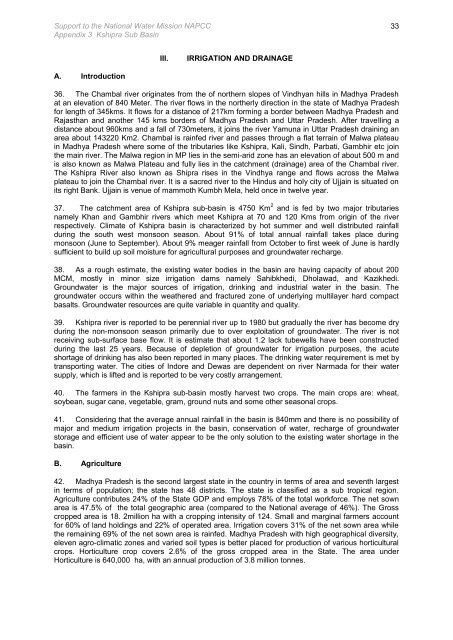Kshipra Sub Basin - Asian Development Bank
Kshipra Sub Basin - Asian Development Bank
Kshipra Sub Basin - Asian Development Bank
You also want an ePaper? Increase the reach of your titles
YUMPU automatically turns print PDFs into web optimized ePapers that Google loves.
Support to the National Water Mission NAPCC<br />
Appendix 3 <strong>Kshipra</strong> <strong>Sub</strong> <strong>Basin</strong><br />
A. Introduction<br />
III. IRRIGATION AND DRAINAGE<br />
36. The Chambal river originates from the of northern slopes of Vindhyan hills in Madhya Pradesh<br />
at an elevation of 840 Meter. The river flows in the northerly direction in the state of Madhya Pradesh<br />
for length of 345kms. It flows for a distance of 217km forming a border between Madhya Pradesh and<br />
Rajasthan and another 145 kms borders of Madhya Pradesh and Uttar Pradesh. After travelling a<br />
distance about 960kms and a fall of 730meters, it joins the river Yamuna in Uttar Pradesh draining an<br />
area about 143220 Km2. Chambal is rainfed river and passes through a flat terrain of Malwa plateau<br />
in Madhya Pradesh where some of the tributaries like <strong>Kshipra</strong>, Kali, Sindh, Parbati, Gambhir etc join<br />
the main river. The Malwa region in MP lies in the semi-arid zone has an elevation of about 500 m and<br />
is also known as Malwa Plateau and fully lies in the catchment (drainage) area of the Chambal river.<br />
The <strong>Kshipra</strong> River also known as Shipra rises in the Vindhya range and flows across the Malwa<br />
plateau to join the Chambal river. It is a sacred river to the Hindus and holy city of Ujjain is situated on<br />
its right <strong>Bank</strong>. Ujjain is venue of mammoth Kumbh Mela, held once in twelve year.<br />
37. The catchment area of <strong>Kshipra</strong> sub-basin is 4750 Km 2 and is fed by two major tributaries<br />
namely Khan and Gambhir rivers which meet <strong>Kshipra</strong> at 70 and 120 Kms from origin of the river<br />
respectively. Climate of <strong>Kshipra</strong> basin is characterized by hot summer and well distributed rainfall<br />
during the south west monsoon season. About 91% of total annual rainfall takes place during<br />
monsoon (June to September). About 9% meager rainfall from October to first week of June is hardly<br />
sufficient to build up soil moisture for agricultural purposes and groundwater recharge.<br />
38. As a rough estimate, the existing water bodies in the basin are having capacity of about 200<br />
MCM, mostly in minor size irrigation dams namely Sahibkhedi, Dholawad, and Kazikhedi.<br />
Groundwater is the major sources of irrigation, drinking and industrial water in the basin. The<br />
groundwater occurs within the weathered and fractured zone of underlying multilayer hard compact<br />
basalts. Groundwater resources are quite variable in quantity and quality.<br />
39. <strong>Kshipra</strong> river is reported to be perennial river up to 1980 but gradually the river has become dry<br />
during the non-monsoon season primarily due to over exploitation of groundwater. The river is not<br />
receiving sub-surface base flow. It is estimate that about 1.2 lack tubewells have been constructed<br />
during the last 25 years. Because of depletion of groundwater for irrigation purposes, the acute<br />
shortage of drinking has also been reported in many places. The drinking water requirement is met by<br />
transporting water. The cities of Indore and Dewas are dependent on river Narmada for their water<br />
supply, which is lifted and is reported to be very costly arrangement.<br />
40. The farmers in the <strong>Kshipra</strong> sub-basin mostly harvest two crops. The main crops are: wheat,<br />
soybean, sugar cane, vegetable, gram, ground nuts and some other seasonal crops.<br />
41. Considering that the average annual rainfall in the basin is 840mm and there is no possibility of<br />
major and medium irrigation projects in the basin, conservation of water, recharge of groundwater<br />
storage and efficient use of water appear to be the only solution to the existing water shortage in the<br />
basin.<br />
B. Agriculture<br />
42. Madhya Pradesh is the second largest state in the country in terms of area and seventh largest<br />
in terms of population; the state has 48 districts. The state is classified as a sub tropical region.<br />
Agriculture contributes 24% of the State GDP and employs 78% of the total workforce. The net sown<br />
area is 47.5% of the total geographic area (compared to the National average of 46%). The Gross<br />
cropped area is 18. 2million ha with a cropping intensity of 124. Small and marginal farmers account<br />
for 60% of land holdings and 22% of operated area. Irrigation covers 31% of the net sown area while<br />
the remaining 69% of the net sown area is rainfed. Madhya Pradesh with high geographical diversity,<br />
eleven agro-climatic zones and varied soil types is better placed for production of various horticultural<br />
crops. Horticulture crop covers 2.6% of the gross cropped area in the State. The area under<br />
Horticulture is 640,000 ha, with an annual production of 3.8 million tonnes.<br />
33
















